Excessive strain
Especially when landing after a jump, a maximum tensile load is applied to the kneecap In addition to the intensity, the frequency of the strain and the individual’s physical condition play an important role.

Patella tip syndrome is a chronic inflammation of the patellar tendon’s insertion point on the kneecap. It usually occurs after excessive strain and can be accurately diagnosed because the pain is clearly located at the lower patella tip and can be easily reproduced during an examination.
Patella tip syndromeis divided into four levels. At the first level, pain occurs exclusively after heavy strain. At the second level, pain occurs at the beginning of and after strain. At the third level, the pain is constant. At the fourth level, the patellar tendon will tear.
Patella tip syndrome is the most common knee condition in elite athletes and aspiring amateur athletes. Sports with high tensile loads on the patellar tendon, such as during jumping or shock absorbing, are particularly prone to patella tip syndrome. In addition to high jump and long jump, this also includes ball sports such as volleyball and basketball as well as weight lifting and endurance running on hard surfaces.
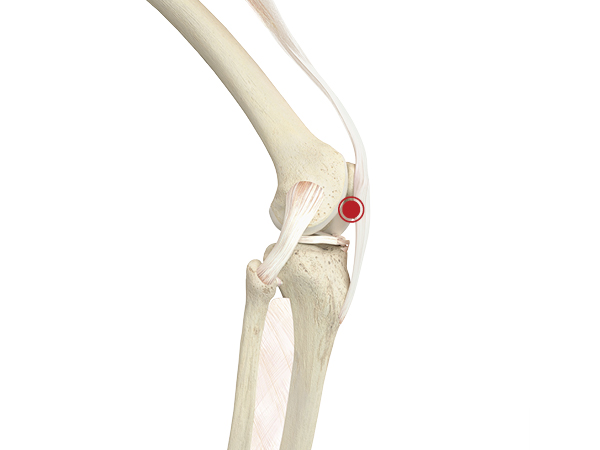
Patella tip syndrome is an inflammation of the tendon that connects the thigh muscle with the shin (tibia) via the kneecap (patella). It occurs at the lower end of the kneecap directly on the transition between patellar tendon and patella.
Most people probably know patella tip syndrome (PTS) by the colloquial description “jumper’s knee.” The technical terms patellar tendinitis, patellar tendinosis, enthesiopathy and patellar tendinopathy are also used.
Patella tip syndrome is caused by chronic excessive strain on the tendon insertion point. The strain is strongest when the knee is bent because the tendon insertion point is flexed and tensed.
Three areas can generally be involved in triggering patella tip syndrome: the active musculoskeletal system (muscles and tendons), the passive musculoskeletal system (bones, joints and ligaments) and the individual body posture.
Excessive strain
Especially when landing after a jump, a maximum tensile load is applied to the kneecap In addition to the intensity, the frequency of the strain and the individual’s physical condition play an important role.
Tensile forces caused by imbalances
A congenital ligament weakness, shortened or hardened thigh muscles, a shorter leg or other physical imbalances can increase the tensile forces that are exerted on the patellar tendon.
High-riding patella
In the case of high-riding patella, also known as patella alta or high-riding kneecap, the kneecap has shifted upwards, thus exerting increased tensile forces on the patellar tendon when the knee is bent. High-riding patella can be congenital or acquired.
Misalignment (of the patella)
If the kneecap shifts outwards, additional strain is applied, which can result in problems.
To lay the foundation for successful treatment of patella tip syndrome, it’s firstly important to stop whatever is causing the strain. Depending on the intensity, a break of six to twelve weeks is recommended before starting to train again.
In the case of chronic or acute pain, a patella strap, such as the JuzoFlex Patella Xtra, helps to guide and stabilise the kneecap. The massage effect exerted by the nubs promotes blood circulation and therefore the healing process. If the cause of patella tip syndrome is a foot misalignment, orthopaedic insoles can compensate for imbalances. In severe cases, an orthosis such as the JuzoPro Patella Xtec provides additional stability, making it even more effective.
The best treatment for patella tip syndrome
Depending on the level, pain pattern and indication, various types of physical therapy are used for patella tip syndrome. In addition to massages and physiotherapy, other options are thermotherapy, electrotherapy, ultrasound and shock wave therapy. The individual measures can be arranged and combined depending on the cause.
In order to reduce strain on the tendon insertion point, sporting activities that feature jumps or other extreme or frequent tensile loads should be avoided. To strengthen the supporting muscles, you and your doctor should discuss switching to gentler exercises, such as cycling or aqua jogging. Regularly stretching of the thigh muscles can reduce tension on the kneecap, while other targeted exercises can compensate for imbalances.
Eccentric exercises are particularly suitable during training. They contract the muscle quickly. Muscle tension generated in this way is relieved slowly and in a controlled manner during the eccentric phase.
The patella strap improves the physiological guidance of the patella, thus promoting pain-free mobility. Tailor-made exercises help to strengthen the supporting muscles and compensate for imbalances. Juzo has collated the following selection of exercises in cooperation with therapists.
Level 1: Movement control
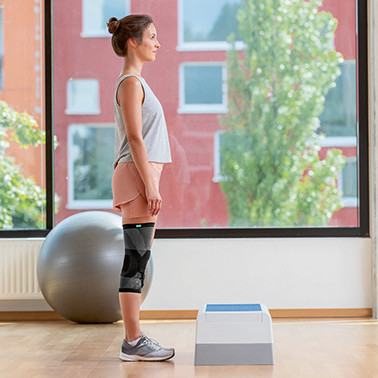
Step-up: Step 1
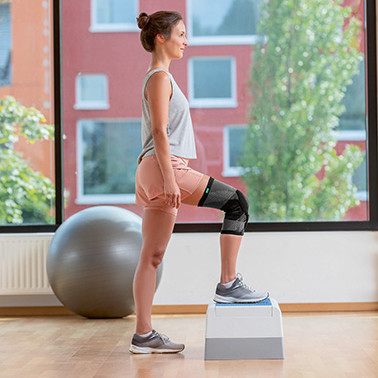
Step-up: Step 2

Step-up: Step 3
Stand with your feet hip-width apart, in front of an exercise step or a similar stable object (ca. 20 cm). With a controlled movement, climb onto the step. Ensure that the knee doesn’t go further than your toes.
3 x approx. 15 to 20 repetitions on each side
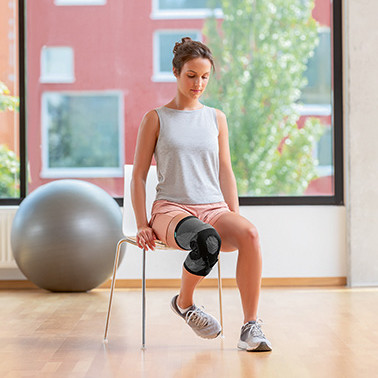
Seated diagonal movement: Step 1
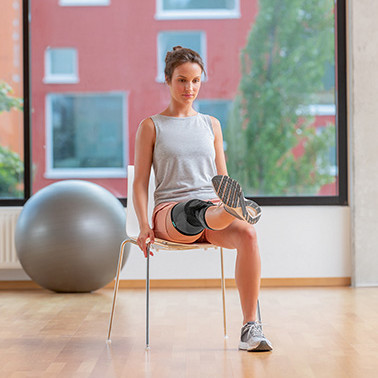
Seated diagonal movement: Step 2
Sit on a chair, with your legs bent at a 90° angle. Raise one leg towards your chest, with your toes rotated inwards. Extend your leg and rotate your toes as far outwards as possible.
3 x approx. 15 to 20 repetitions on each side
Level 2: Co-ordination
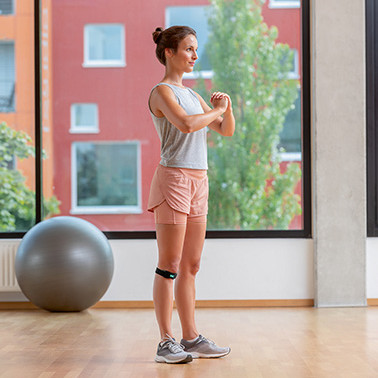
Squats with different leg angles: Step 1
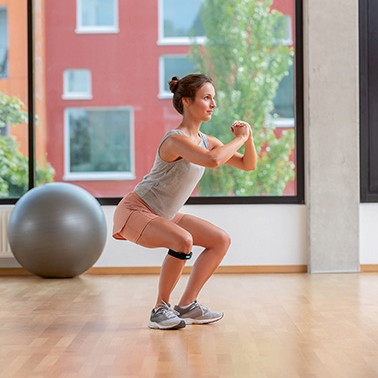
Squats with different leg angles: Step 2
Stand with your legs about shoulder-width apart, feet slightly turned outwards. Important: Your knees and toes must always point
in the same direction. Bend your knees slowly (your buttocks move backwards) and then return to the starting position.
3 x 10 to 15 repetitions
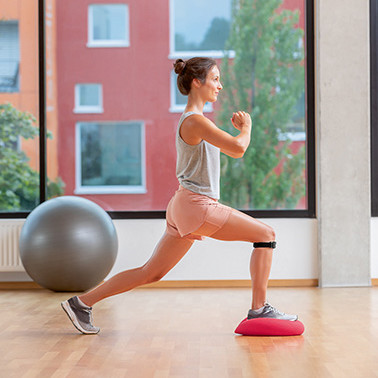
Split-squats: Step 1
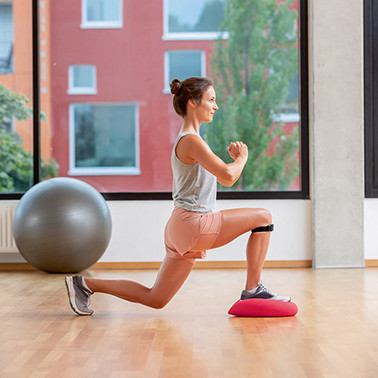
Split-squats: Step 2
Take a big step forwards in a straight line. Bend the back knee. Ensure that the knee doesn’t go further than your toes.
3 x 10 to 15 repetitions on each side
Level 3: Strengthening

Wall-sit: Step 1
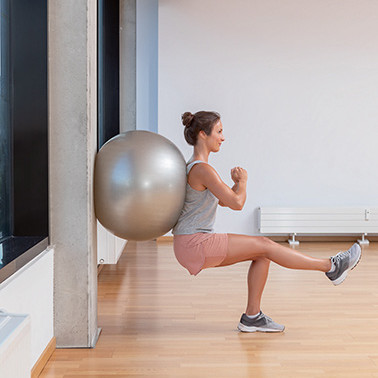
Wall-sit: Step 2
Stand with your back against a wall (ideally with a soft ball). Slowly squat down whilst extending one leg forwards in a flowing movement.
3 x 10 to 15 repetitions
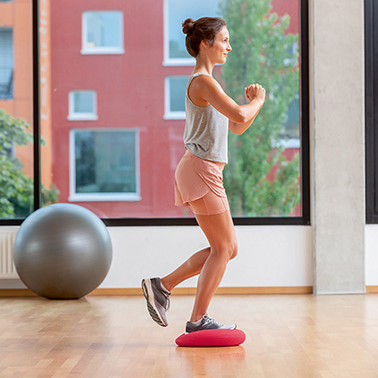
Single-leg squats: Step 1
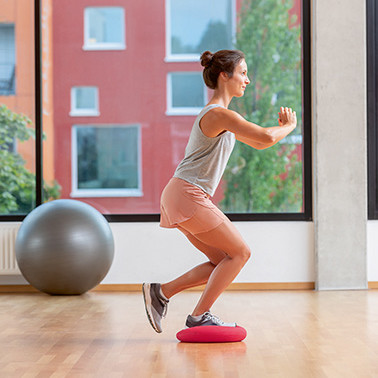
Single-leg squats: Step 2
For this exercise you need to stand on something instable, such as a soft cushion or a balance pad. Stand on the cushion with one leg. Raise the other leg and bend the knee.
3 x 10 to 15 repetitions on each side
Surgery should only be considered as the last option for patella tip syndrome. If conservative treatment does not cause long-term improvement, there are open as well as minimally invasive surgical options.